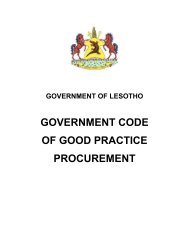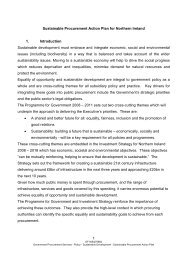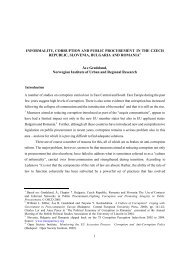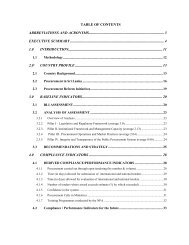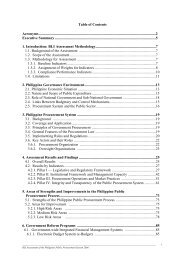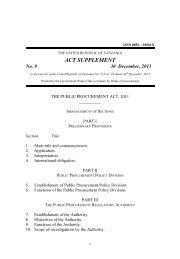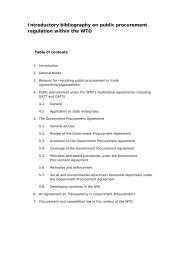Challenges in Public Procurement - unpcdc
Challenges in Public Procurement - unpcdc
Challenges in Public Procurement - unpcdc
You also want an ePaper? Increase the reach of your titles
YUMPU automatically turns print PDFs into web optimized ePapers that Google loves.
CHALLENGES IN PUBLIC PROCUREMENT 13between centralized or decentralized procurement platforms, theprocurement policy choices, represented by lowest purchase price or valuefor-money,also have to be resolved. Conflict<strong>in</strong>g demands <strong>in</strong>clude the needto enhance government management of procurement with<strong>in</strong> the constra<strong>in</strong>tsof a tender-driven contract<strong>in</strong>g policy framework, while assur<strong>in</strong>g high levelsof probity, accountability and transparency, whilst also satisfy<strong>in</strong>g the diversegovernance expectations of stakeholders.<strong>Public</strong>/private partnerships have become more and more popular <strong>in</strong>public procurement, accord<strong>in</strong>g to Alexander Batran, Michael Essig, andBerthold Schefer, <strong>in</strong> “<strong>Public</strong>-Private Partnerships As an Element of <strong>Public</strong><strong>Procurement</strong> Reform <strong>in</strong> Germany.” Just like <strong>in</strong> other countries,public/private partnerships (PPPs) are becom<strong>in</strong>g <strong>in</strong>creas<strong>in</strong>gly more popular<strong>in</strong> Germany. At the moment, there are several cases which give deep<strong>in</strong>sights <strong>in</strong>to the success factors of PPPs. As a result, PPPs are also seen asone key element for reform<strong>in</strong>g the public sector <strong>in</strong> Germany, and lead<strong>in</strong>gtowards many challenges for public procurement. In this chapter, theauthors provide a conceptual and theoretical overview of PPPs, andexam<strong>in</strong>e comprehensively a PPP case, the German Aerospace Center(Deutches Zentrum Fur Luft- Und Raumfahrt E.V./DLR).Accord<strong>in</strong>g to Wendell C. Lawther and Lawrence L. Mart<strong>in</strong>, <strong>in</strong> “<strong>Public</strong><strong>Procurement</strong> Partnerships,” recent experience with public procurementefforts <strong>in</strong> the U.S. suggests dissatisfaction with both governmental deliveryof services and result<strong>in</strong>g efforts to privatize or outsource these services.There is <strong>in</strong>creas<strong>in</strong>g recognition that both approaches should be comb<strong>in</strong>ed toacquire <strong>in</strong>creas<strong>in</strong>gly complex goods and services, rely<strong>in</strong>g upon publicprocurement partnerships. Various trends have impacted public acquisition<strong>in</strong> recent years, further support<strong>in</strong>g the need for partnerships. These <strong>in</strong>cludea decl<strong>in</strong><strong>in</strong>g public procurement workforce, an expanded role forprocurement practitioners, the complexity of acquir<strong>in</strong>g <strong>in</strong>formationtechnology systems, the need for flexibility <strong>in</strong> negotiat<strong>in</strong>g contracts andpartnership arrangements, as well as the <strong>in</strong>creas<strong>in</strong>g visibility of risks and theneed to manage them effectively. In light of these trends, four examplesillustrat<strong>in</strong>g a range of partnerships are discussed <strong>in</strong> more detail, illustrat<strong>in</strong>g<strong>in</strong>novative responses from a variety of local, state and federal partnerships.In “An Exploratory Analysis of <strong>Public</strong> <strong>Procurement</strong> Practices <strong>in</strong>Europe,” Gustavo Piga and Matteo Zanza present some prelim<strong>in</strong>ary resultsof an exploratory analysis of public procurement practices <strong>in</strong> Europe. Theanalysis is realized by collect<strong>in</strong>g and process<strong>in</strong>g data and <strong>in</strong>formationprovided by detailed questionnaires sent to a selected group of organizationsrepresent<strong>in</strong>g twenty-four European countries. The organizations selected are



